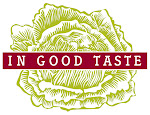In the Crust we Trust
The crust is almost always developed during the first part of the roasting process by one of two techniques:
1.
Oven searing uses the high heat of the oven (400°F to 450° F typically) to develop the golden brown crust. Following are some searing times according to
roast size:
A. Up
to 4 pounds – 20 minutes
B. 4
to 6 pounds – 30 minutes
C. 6
pounds or more – 40 minutes or more
2.
Pan searing develops the crust by cooking the
meat first on the stovetop with a roasting pan, such as a sauté pan or preferably,
a cast iron skillet. The roasts are
seasoned and then seared in the pan with a fat until each side of the roast is
deep golden brown. Pan searing is
especially useful for developing a crust on smaller or more delicate meats,
such as cote de boeuf. I like to let the
meat rest for a few minutes or even longer before finishing it in the
oven. This allows the heat to move to
the center of the roast and further temper it.
Try using pan searing to develop a crust on the roast and then let it
rest at room temperature while finishing other parts of the meal. It’s a great trick to help out with timing.
Heat it up and settle it down!
It’s important to use high heat
to get that beautiful golden brown crust, but if a roast is cooked at high
temperatures for the entire time, the results would be dry, overcooked and
chewy meat. Therefore; it is important
that once the crust is developed that the oven temperature is lowered to
somewhere between 275°F to
325°F. I prefer 300°F when finishing a roast.
So it’s high heat to develop the crust and then lower heat to gently
finish cooking the roast.



